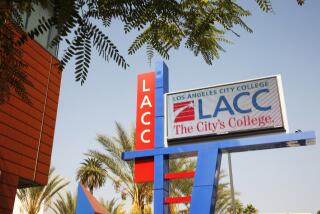Tap Private Awards to Pay Tuition
- Share via
Here’s news for all those students who believe that scholarships are only for the poor and academically or physically gifted.
You can get a scholarship for being left-handed, having a pet, a hobby--even for having a disease.
Specifically:
* At Juniata College in Pennsylvania, southpaws compete for a $20,000 grant donated by Frederick and Mary F. Beckley, who met and married after they were paired up on the tennis court. They were both left-handed.
* Duracell gives out $1,000 scholarships to those who build “any original working device” with a Duracell battery. And Brunswick gives money to kids who bowl.
* The Dog Writers Educational Trust offers scholarships for students who have been active in showing, breeding and judging dogs.
Schering-Plough Foundation, a division of the national pharmaceutical concern, gives grants to athletes with asthma.
And these scholarships are just the tip of the iceberg. They are part of one of the least-known sources of financial aid to students--so-called private donor or restricted recipient awards.
Literally hundreds of thousands of these privately funded scholarships and awards are available each year. But because there is no one repository of information about them, financial aid experts maintain that billions of dollars in awards go unused each year.
For those looking for more financial help than federal and state programs can provide, these private awards can prove to be a gold mine. Although the bulk of them are modest scholarships--ranging from $50 to $1,000 a piece--some actually pay full tuition costs. Better still, there’s no limit to how many a student can apply, and qualify, for. An enterprising student can receive dozens.
Indeed, often the toughest part about getting a private donor award is finding it. Although some are available no matter where you go to school, others are given only to students at particular universities.
Financial aid counselors usually know about their own school’s proprietary private donor awards, but they often don’t know about the others. In addition, few think to ask the oft odd-ball questions that determine whether a student qualifies.
Financial aid applications don’t state whether a student is fluent in the Polish language, for example. But, if they are, they can qualify for a grant at Chicago’s Loyola University. Those who studied Latin or Greek in high school can qualify for the Condon Scholarship at Loyola, which could pay all four years’ tuition.
Equally generous awards are often available to those who choose particular careers. Students interested in math, science, engineering, medicine, dentistry and nursing can often tap into full-tuition awards given out by companies and trade groups anxious to forward their professions.
Your ethnic background can also be a plus. If you are a Native American, African American, Polish, Jewish or Syrian, for example, there are either national or local groups willing to help you go to college.
How do you find these scholarships? Either through personal research or a scholarship search service.
There are dozens of scholarship search services operating throughout the country, including Granada Hills-based Money for College and Calabasas-based Lighthouse Scholarship Network, an affiliate of Educational Services of America in Northbrook, Ill. They usually operate through a series of licensees that charge between $50 and $100 per search.
Students fill out an applications that asks what schools they plan to attend, intended majors, hobbies, interests, work experience and background. The information is fed into a computerized database, which spits out a list of potential scholarship sources.
These search services usually guarantee a minimum number of referrals, but they don’t generally guarantee that your child will receive a scholarship. All they do is advise you of the names and addresses of groups that offer awards for which the student qualifies. Some also provide form letters to request scholarship applications. After that, it’s up to the student.
But even these services, which boast information on up to 300,000 awards, don’t have information on every scholarship that’s available. Those who are serious about getting all the aid possible may have to do a little searching on their own to ensure they’ve matched all the idiosyncrasies of their children and family to the idiosyncrasies of all the various scholarships.
There are numerous books in the public library that list the scholarships available at various universities and in various states and counties. Some donors also advertise around this time of year. Parents and students need to keep their eyes peeled.
Next: New laws could drastically affect financial aid.
More to Read
Sign up for Essential California
The most important California stories and recommendations in your inbox every morning.
You may occasionally receive promotional content from the Los Angeles Times.













